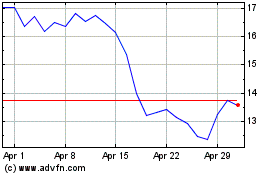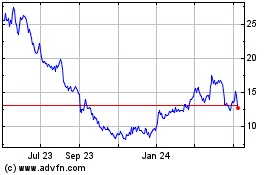Enanta Pharmaceuticals to Present New Preclinical Data on EDP-305, an FXR Agonist for NASH and PBC, at The Liver Meeting® 2017
October 20 2017 - 8:02AM
Business Wire
Enanta Pharmaceuticals, Inc. (NASDAQ:ENTA), a chemistry-driven
biotechnology company dedicated to creating and developing small
molecule drugs for viral infections and liver diseases, today
announced new data presentations on EDP-305, Enanta’s lead
Farnesoid X receptor (FXR) agonist being developed for
non-alcoholic steatohepatitis (NASH) and primary biliary
cholangitis (PBC), will be presented at The Liver Meeting® 2017,
the Annual Meeting of the American Association for the Study of
Liver Diseases (AASLD), taking place October 20-24, 2017 in
Washington, D.C.
EDP-305 has demonstrated potency and efficacy in a variety of
NASH, fibrosis and cirrhosis animal models. EDP-305 has completed a
Phase 1 clinical study in healthy subjects and in subjects with
presumed non-alcoholic fatty liver disease (obese, with or without
pre-diabetes or type 2 diabetes mellitus). Further studies are
planned in NASH and PBC patients.
EDP-305 is a potent agonist of FXR, a nuclear receptor that is
the main regulator of bile acid levels in the liver and small
intestine. FXR responds to bile acids by regulating gene
transcription of key enzymes and transporters, many of which play
important roles in lipid metabolism, insulin resistance,
inflammation, and fibrosis.
The following will be presented during The Liver Meeting®
2017:
Friday, October 20Presidential Poster of Distinction,
8:00 am - 5:30 pm ETSession: Basic Fibrosis Research and Stellate
Cell Biology#367 – “A novel FXR agonist EDP-305 potently
suppresses hepatic stellate cell activation and hepatic fibrosis in
chronic mouse models of biliary and metabolic liver
disease”
- Data demonstrates that EDP-305 directly
inhibits hepatic stellate cell proliferation in vitro and improved
pre-established liver injury and hepatic fibrosis in biliary and
metabolic models of liver disease in mice.
Monday, October 23Oral Presentation, 8:00 - 9:30 am
ETParallel Session 23: Steatosis and Steatohepatitis: Experimental
I#162 – “Significant anti-fibrotic efficacy of EDP-305, a highly
potent and selective farnesoid X receptor (FXR) agonist, in a rat
model of thioacetamide-induced liver fibrosis and
cirrhosis”
- EDP-305 exhibits excellent
anti-fibrotic efficacy in rats with ongoing TAA-induced
fibrosis.
Monday, October 23Presidential Poster of Distinction,
8:00 am - 5:30 pm ETSession: Steatohepatitis: Experimental#1988
– “EDP-305 favorably regulates lipoprotein mechanism in
vitro”
- In vitro data demonstrates that EDP-305
maintains a positive effect on lipoprotein metabolism under
steatotic conditions by not altering LDLR or SRB1 expression,
without increasing ApoB secretion.
About EDP-305, a Farnesoid X Receptor (FXR)
AgonistEDP-305 is a potent FXR agonist and Enanta’s lead
product candidate being developed for the treatment of NASH and
PBC. EDP-305 represents a new class of FXR agonists that has been
designed to take advantage of increased binding interactions with
the receptor. Further, this non-bile acid class contains steroidal
and non-steroidal components, and does not contain the carboxylic
acid group that can lead to the formation of taurine and glycine
conjugates normally associated with bile acids, and that may also
be present in other classes of FXR agonists.
About NAFLD, NASH, and FXRNon-alcoholic fatty liver
disease (NAFLD) is the accumulation of excessive fat in the form of
triglycerides in patients’ liver cells (steatosis) that is not
caused by alcohol. NAFLD is widely considered to be the liver
expression of metabolic disease associated with type 2 diabetes,
insulin resistance, obesity, and hyperlipidemia. A subgroup of
NAFLD patients has liver cell injury and inflammation in addition
to excessive fat (steatohepatitis). Progression of this condition
leads to non-alcoholic steatohepatitis (NASH). Patients with NASH
can develop fibrosis and ultimately cirrhosis of the liver,
potentially leading to hepatocellular carcinoma or requiring a
liver transplant. Farnesoid X receptor (FXR) is a nuclear receptor
and a main regulator of bile acid levels in the liver and small
intestine. It responds to bile acids by regulating gene
transcription of key enzymes and transporters, many of which play
important roles in lipid metabolism, insulin resistance,
inflammation, and fibrosis.
About EnantaEnanta Pharmaceuticals has used its robust,
chemistry-driven approach and drug discovery capabilities to become
a leader in the discovery and development of small molecule drugs
for the treatment of viral infections and liver diseases. Two
protease inhibitors, paritaprevir and glecaprevir, discovered and
developed through Enanta’s collaboration with AbbVie, have now been
approved in jurisdictions around the world as part of AbbVie’s
direct-acting antiviral (DAA) regimens for the treatment of
hepatitis C virus (HCV) infection, including the U.S. marketed
regimens MAVYRET™ (glecaprevir/pibrentasvir) and VIEKIRA PAK®
(paritaprevir/ritonavir/ombitasvir/dasabuvir).
Royalties and milestone payments from the AbbVie collaboration
are helping to fund Enanta’s research and development efforts,
which are currently focused on the following disease targets:
non-alcoholic steatohepatitis (NASH)/ primary biliary cholangitis
(PBC), respiratory syncytial virus (RSV) and hepatitis B virus
(HBV). Please visit www.enanta.com for more information.
View source
version on businesswire.com: http://www.businesswire.com/news/home/20171020005172/en/
Investor ContactEnanta Pharmaceuticals, Inc.Carol Miceli,
617-607-0710cmiceli@enanta.comorMedia ContactMacDougall
Biomedical CommunicationsKari Watson,
781-235-3060kwatson@macbiocom.com
Enanta Pharmaceuticals (NASDAQ:ENTA)
Historical Stock Chart
From Mar 2024 to Apr 2024

Enanta Pharmaceuticals (NASDAQ:ENTA)
Historical Stock Chart
From Apr 2023 to Apr 2024
